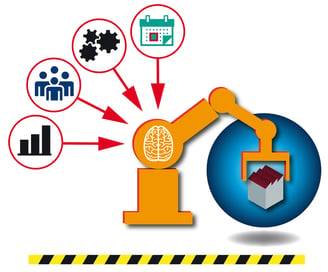How-to: Optimizing Your Planning Flow
Brian Hoey - September 25, 2018

 Let's say you're an OEM, with a sleek manufacturing space and a sophisticated, technologically cutting edge process for creating a particular automotive part. But you have a problem: At this point, your incredibly sophisticated production techniques aren't not being complemented by an equally sophisticated, multi-level approach to production planning and resource scheduling. This results in a disconnect between the high quality of your products and your ability to maximize capacity and meet customer delivery requirements. How can you build towards a production planning workflow that complements your product and fulfills your business goals?
Let's say you're an OEM, with a sleek manufacturing space and a sophisticated, technologically cutting edge process for creating a particular automotive part. But you have a problem: At this point, your incredibly sophisticated production techniques aren't not being complemented by an equally sophisticated, multi-level approach to production planning and resource scheduling. This results in a disconnect between the high quality of your products and your ability to maximize capacity and meet customer delivery requirements. How can you build towards a production planning workflow that complements your product and fulfills your business goals?
The Challenge
For your company, creating performance quality parts is at once complex and incredibly delicate, meaning that your production flows are often constrained by the presence or absence of key resources and materials (e.g. the alloys that make up the products). Each part depends on a number of components that have to be on hand for production, but small variations in the makeup of various products make it difficult to accurately track the production requirements of each order that needs to be fulfilled. Low production visibility makes it difficult to group together orders with similar attributes and resource requirements, meaning that reaching an optimal distribution of tasks for a given set of orders is virtually impossible.
These types of issues are far from uncommon in the automotive manufacturing sector, but you're invested in implementing a multi-stage planning solution that alleviates pain points like complex material requirements and difficult production sequencing. What steps can you take to get there?
Order Generation
Your first step in working to improve your planning workflows is to adopt a component scheduling solution, which should easily integrate right off the bat with your existing ERP system in order to turn order management data, scrap data, and inventory levels into legible, usable production orders. In this way, you can get a handle on your existing capacity needs and begin building out a planning framework that accounts for the similarities and differences of each order in terms of materials and sequencing requirements. Thus, rather than manually creating each order as it comes in, planners gain the benefits of automatically generated orders: reduced administrative labor, plus decreased potential for silos, assuming you integrate an easily accessible interface that ensures that mission critical order data can be accessed by key stakeholders.
Attribute and Constraint Management
With all of your orders centralized and standardized, you can begin work on the next phase of integration for your multi-stage planning workflow: attribute and constraint management. Because each individual order has been made available in the scheduling interface, they can also be tagged with the necessary materials, resources, and restrictions that go with each product, and then grouped together based on those materials and restrictions. As a result, production plans can be managed in a dynamic, optimized way. If, for instance, a shipment of a particular resource was late, production plans could easily be altered so that all of the products that didn’t require that resource could be grouped together and manufactured first thing while planners waited for the late materials to arrive.
By the same token, all products that feature a specific restriction (like a cool-down process between production stages or a manual intervention within an otherwise automated workflow) could be grouped strategically in such a way as to maximize production capacity. If two separate parts orders needed to be fulfilled, for instance, planners could visualize the total time and cost of doing one order after the other compared to slotting different components sections of each order in an alternating manner, and then choose the optimal path from there. Advanced algorithms could group production workflows together in such a way as to cause synergy and synchronicity, thereby increasing efficiency, shortening lead times, and staving off disruptions.
Results: Smoother Production Planning
With each order centralized and grouped by attributes and constraints, you should be able to position yourself to choose the optimal production scheme for any given order or group of orders. Not only that, but if this information is aggregated in a highly visible way within an adaptable planning view module, planners can perform extensive analyses, calculations, and “what-if” scenarios for all of their plans. The result is a level of coverage and flexibility within any given plan that ensures that planners can make informed, optimized choices, even in the face of supply chain events or other unexpected bottlenecks or breakdowns.
The key here is that, whatever happens, planners are able to refer to a legible, centralized source of scheduling and order information. Confusion and complexity within production processes are reduced by tools designed to help planners understand their options and weigh each one against the other in terms of cost, lead-times, etc. In this way, your business can build an integrated approach to planning that matches your innovative manufacturing processes.
LATEST POSTS
- Understand Circular Economy in The Manufacturing Industry
- How Can Industry 4.0 IT Integration Be Achieved Smoothly?
- The Significance of Order Sequencing in Discrete Manufacturing
- How to improve your Supply Chain Management: The Power of Control Towers
- Optimizing Human Resource Scheduling in Manufacturing: A Technological Approach



